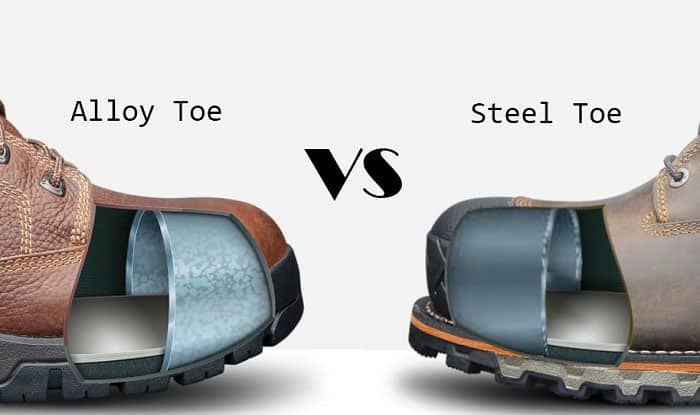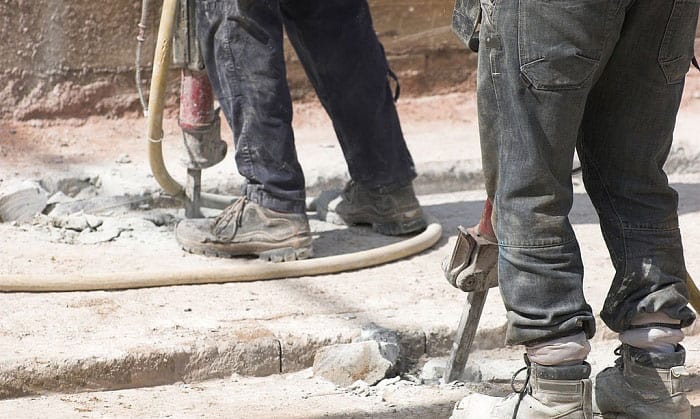The most well-known protective toe work boots are steel toe ones. It is because steel is sturdy, long-lasting, and cost-effective, but they can be heavy and uncomfortable. Throughout history, designers have invented alloy toe boots as an upgrade for steel ones. However, steel-capped boots remain popular for several reasons.
Lately, we have been receiving comments from people asking whether alloy toe boots are better than steel ones. It is difficult to give one short answer as it depends on multiple factors. In this article, we will take a closer look at alloy toe vs steel toe similarities and differences. We will weigh them up in terms of safety ratings, comfort, durability, weight, and price. Dive in for more details!
Table of Contents
Is Alloy Toe the Same as Steel Toe?
Many people mistake steel for alloy toe, thinking they are the same material. To some extent, it is true as they are both made from metal. But they have different names for a reason.
Steel toe boots: These are also called steel toe caps, steel-capped boots, or safety boots. The boot is reinforced with a thin steel cap under the upper toe area to prevent injuries from rolling or falling objects.
Alloy toe boots: The idea is similar to steel-capped boots, except the steel is replaced with alloy. An alloy toe can be made from a variety of materials; aluminum and titanium are the most used. Manufacturers also mix elements like silicon, copper, iron, magnesium, manganese, chromium, and zinc to enhance the flexibility and durability.
Alloy vs Steel Toe: Similarities
Before diving into the differences, let’s quickly look at how alloy and steel toes are similar to each other:
Boot standards: No matter what materials the toe cap is made from, it must pass the same tests of ANSI (American National Standards Institute), ASTM (American Society for Testing Materials), and OSHA (Occupational Safety and Health Administration). The boots must be able to withstand a certain amount of impact and compression to be certified.
Boot materials: The toe cap materials are different but other parts are made of similar materials, such as leather, suede, or synthetic leather.
Safety features: Both come in a variety of safety features, such as steel or composite shank, oil resistance, external heel protection, and so on. For a pair of boots that suit your job, besides the toe cap, you must consider those features.
Alloy vs Steel Toe: Differences
1. Weight
The most significant difference between the two is their weight. Alloy toe was invented with the intention to make the boots more lightweight. Generally speaking, alloy is 30 to 50 percent lighter than steel. For people who stand for hours, walk long distances, or carry heavy loads daily, this 30 to 50 percent can make a huge difference.
However, the toe cap only contributes a little to the total weight of a boot. If you are looking for lightweight boots, you should also consider other factors like the shank, sole, and upper part materials. Here are some tips that will be helpful:
- Leather is one of the heaviest fabric materials, but its thickness and hardness provide maximum protection. An alternative choice is suede, known as split leather. As the name implies, suede is made by splitting a piece of leather, which makes it thinner and more lightweight.
- Most safety boot soles are made from rubber. Rubber is long-lasting, resilient, and can provide resistance to oil, heat, water. Though quite heavy, rubber is almost irreplaceable. An option is to look for ThermoPlastic Rubber or TPR sole. They have protective features of rubber while weighing less.
Before purchasing boots, always make sure they meet the safety standards.
2. Safety ratings
As mentioned above, all safety boots must pass the same impact and compression tests to go out on the market. Rest assured that whatever toe cap you choose, it can protect your toes. Still, due to the heavy and sturdy nature of steel, steel-capped boots exceed the standards and provide higher protection. If your job involves dealing with heavy loads, running chainsaw, heavy-duty equipment, steel toe cap boots are the best bet.
Other than that, a common misunderstanding is that metal, steel and alloy toe cap footwear cannot prevent electrical hazards. That is not the case though.
According to the OSHA, the organization does not consider steel or alloy toe shoes to be hazardous to electrical tradesmen. But the metal toe cap must not be in contact with the employee’s foot and is not exposed to the outer environment.
Still, for maximal safety, most manufacturers only use composite toe caps in their anti electric shock shoes. The advice is to look for the electrical hazard green tick on the products themselves. As long as the boots are electrical hazard rated, it doesn’t matter what materials the toe caps are made from.
Last but not least, both boot kinds stand chances to set off metal detectors. If you work in the airport or close to a metal detector, composite-capped boots will keep you away from the annoying alert sound.
3. Comfort
In general, alloy toes are made a bit thinner. This is the designers’ intention to create more room and comfort in the toe box. Plus, alloy is more lightweight. So, alloy-capped footwear feels more comfy.
The toe cap features only play a small role in the overall comfort level of a boot. To make sure your feet are supported and comfortable, also be aware of:
- A good fit: Safety boots must fit snugly to your feet.
- Cushioning and padding: Work boots can be weighty due to their safety features; it’s unavoidable. Add cushioning and padding to support the feet if needed.
- The right socks: Only wear socks that are soft and thick enough. Socks should never cause blisters or chafing to your feet.
4. Durability
When bad injuries happen, steel is more resilient. Both boot kinds will protect your feet, but the thinner alloy might crack after the event.
5. Price
Generally speaking, alloy toe boots run a bit more expensive as they can provide much more comfort while maintaining the safety standards. Among all kinds, steel is the most cost-effective safety footwear. This is the reason why they are popular despite the innovation of other materials. Moreover, in terms of sturdiness and protection, no material can bypass steel.
If price concerns you, watch this video on Top 10 best work boots for workers on a budget for excellent advice.
Conclusion
Choosing the right safety work boots might take time, but it’s definitely worth the effort. Besides preventing injuries, they will provide you extra comfort for long days at work. It is difficult to tell whether alloy or steel toe caps are better as it truly depends on the users’ purposes.
Now that all the information is on the table, it’s up to you to decide alloy toe vs steel toe which ones suit you best. Before you leave, let us know your thoughts in the comment section. See you next time!

Veronica is our content editor. She is a talent in delivery. Her main work is editing and writing articles that are both informative and simple to follow. She is in charge of synthesizing our understanding of what personal protection equipment (PPE) is needed in each job, how to best apply it, and how to visualize that equipment.




